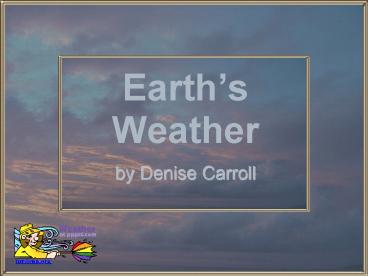Earth PowerPoint PPT Presentation
1 / 23
Title: Earth
1
Earths Weather
- by Denise Carroll
2
Changes in Weather
- Weather is what the air is like outside.
- Weather can be warm or cool.
- Weather can be sunny, windy, or cloudy.
- Weather can change quickly.
- There are four seasons during the year.
3
The Four Seasons
1. Spring begins in March.
- The air is warm, windy, and rainy.
- Trees begin to grow new leaves and flowers.
- Warm air and rain helps plants grow new leaves
and flowers.
4
The Four Seasons
2. Summer begins in June.
- The days are hot and sunny.
- This is the warmest time of the year.
- Leaves are green on trees.
- Storms can make the weather change quickly.
5
The Four Seasons
3. Fall or Autumn begins in September.
- The air begins to get cooler.
- The leaves of some trees change colors and drop
off. - Some plants die.
6
The Four Seasons
4. Winter begins in December.
- The air is cold.
- Some places have snow.
- Winter is the coldest time of the year.
- Many trees have lost their leaves.
7
The Water Cycle
- A water cycle is the way water moves from the air
to land and back again.
8
Condensation
- The water vapor rises into the air, cools, and
condenses into tiny droplets of water. - The drops of water come together to form clouds.
Water Cycle
Precipitation
Evaporation is when a liquid changes to a gas.
The water drops become heavy and fall as rain,
sleet, snow, or hail.
- The suns heat makes water evaporate into water
vapor.
The rain falls or snow melts and flows to
rivers, lakes, and oceans.
9
Meteorologists
- Meteorologists are scientists who use special
tools to measure, predict, and study weather
conditions.
10
Measuring Weather Conditions
- A thermometer measures temperature, or how hot or
cold the air is.
- A rain gauge measures how much rain or snow has
fallen.
- An anemometer measures how fast the wind is
blowing.
- A wind vane shows which direction the wind is
blowing. It points to the direction the wind is
coming from.
11
ThinkWhy do we need to know the weather
conditions each day?
12
Measuring weather conditions helps people.
- People will know how to dress when they go
outside. - People can plan outdoor activities or vacations.
- Scientists can tell people to get ready for bad
weather or a big storm. - Measuring the weather conditions help scientists
predict the weather.
13
Clouds
- Clouds are made up of millions and millions of
small water drops or tiny pieces of ice. - Clouds give us clues about how the weather may
change. - We will learn about these three types of clouds.
- Cumulus
- Cirrus
- Stratus
14
Cumulus
- Cumulus means heap. These clouds look big and
puffy like balls of cotton. - When these clouds start piling up and turn dark,
they can bring a storm.
15
Cirrus
- Cirrus means curl. These clouds are very high up
in the sky. - They look thin or feathery and hold only a little
bit of water. - We see these clouds when the weather is sunny.
16
Stratus
- Stratus means stretched out. These clouds make
the whole sky look dark and gray because they
cover the sky and block the sun. - Stratus are low, gray clouds that usually bring
rain or snow.
17
Preparing for Weather
- Always listen to the radio and television for
weather bulletins. - Stock a good supply of food that does not have to
be cooked. - Store plenty of fresh water.
- Make sure you have flashlights and extra
batteries, candles are not safe. - Be sure your pets are safe.
- Secure loose objects outside your home.
- Always be calm and patient.
18
Thunderstorms
- A thunderstorm has rain, thunder, and lightning.
- When we see big, thick, dark cumulus clouds, we
might expect thunder and lightning to come. - Lightning produces light and heat - called
energy. - When the air is heated that quickly, it expands
(gets bigger) and then contracts (gets smaller).
When the air expands and contracts, it creates an
explosion called THUNDER. - Lightning safety Stay indoors away from doors
and windows. Do not use the telephone. Take off
head sets. Turn off, unplug, and stay away from
appliances, computers, power tools, TV sets.
19
Tornado
- A tornado is a funnel-shaped cloud that spins
very fast. - It has very strong winds that can destroy many
houses and buildings. - It picks up debris or buildings by its swirling
winds. - Tornado safety Stay inside away from windows,
doors and outside walls. Cover your head and body
to protect yourself from flying objects.
20
Hurricane
- A hurricane begins over warm ocean waters and has
winds that are more than 74 mph. - It has strong winds, high ocean waves, and lots
of rain. - It causes floods and destroys many homes and
buildings. - The hurricane season begins June 1 and ends
November 30. - Stay indoors, in the center of your home, in a
closet or bathroom without windows.
21
Blizzard
- A blizzard is a storm with heavy snow and strong
winds. - It is difficult to see outside during a blizzard.
- Blizzard Safety Stay indoors. If you go outside
after the storm, wear layers of clothing.
22
Congratulations
- You have learned about the four seasons, the
water cycle, three types of clouds, storms, and
how to be prepared for weather. - Youre an expert weather watcher!
- REMEMBER TO ALWAYS BE SAFE!
23
Resources
- http//images.search.yahoo.com
- http//office.microsoft.com/clipart
- http//soniacoleman.org/Tutorials/PowerPointTempla
tes/templates1.htm

